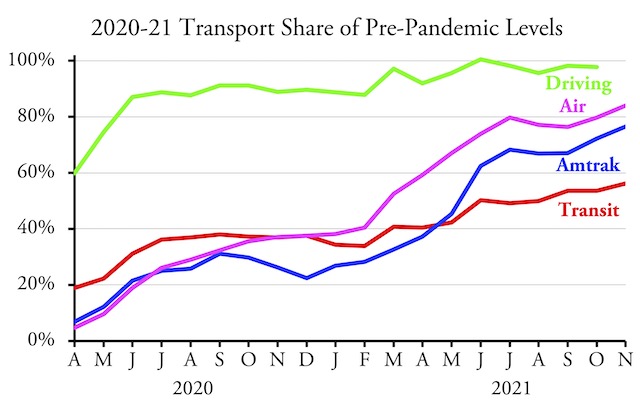The nation’s transit systems carried 56.2 percent as many riders in November 2021 as in November 2019, according to data released by the Federal Transit Administration on Friday. Though an improvement over October’s 53.5 percent, transit still lags behind the airlines, at 84.0 percent, and Amtrak, at 76.6 percent.
Amtrak numbers from its Monthly Performance Report; airline numbers from the Transportation Security Administration; November highway numbers will be available in a week or so.
Transit bus ridership numbers were up to 60.5 percent of pre-pandemic levels while rail numbers reached 52.2 percent. Ridership has still failed to reach 50 percent of pre-pandemic numbers in Detroit (35.4%), San Francisco-Oakland (45.0%), Washington DC (45.5%), Sacramento (48.4%), San Jose (49.1%), and Chicago (49.8%). At the other extreme, ridership has recovered the most in Los Angeles (72.1%), San Diego (64.7%), Tampa-St. Petersburg (63.9%), Las Vegas (63.4%), Dallas-Ft. Worth (62.6%), Houston (61.2%), and San Antonio (60.6%). The New York urban area, which produces about 45 percent of all transit numbers in the U.S., was slightly above average at 58.3 percent.
For those who want to look up their favorite transit agencies or see how transit is doing in other urban areas, I’ve posted an enhanced spreadsheet that totals ridership by year, transit agency, and the 200 largest urban areas. The raw transit data are in cells A1 through IN2243. I’ve added annual totals in columns IO through JH, mode totals in rows 2244 through 2265, agency totals in rows 2270 through 3269 and totals for the 203 largest urban areas in rows 3275 through 3678. Columns JI and JJ show November 2021 numbers as a percent of November 2019 and November 2020. All of these enhancements are on both the UPT (unlinked passenger trips) and VRM (vehicle-revenue miles) worksheets.









Surface transportation numbers are limited by the number of people who want/need to use the service. Airline numbers are largely limited by the number of pilots and cabin crew that aren’t sick or contagious.
The airline industry for months had been confronting labor shortages while consumer demand made a strong comeback. Incentive pay and scaled-back schedules helped the industry get through the Thanksgiving holiday largely without problems.
But then came the Omicron variant, fueling staffing shortages across multiple airlines as crews called in sick. Inclement weather in the Pacific Northwest that spread to the Midwest and East Coast regions has also magnified problems for the industry.
WSJ January 5, 2022